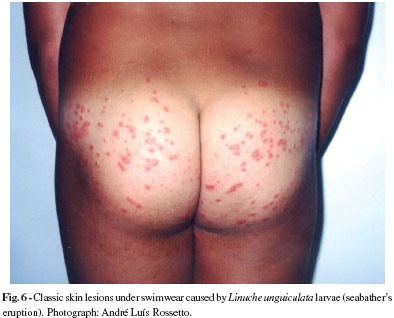This work attempts to establish dermatological identification patterns for Brazilian cnidarian species and a probable correlation with envenoming severity. In an observational prospective study, one hundred and twenty-eight patients from the North Coast region of São Paulo State, Brazil were seen between 2002 and 2008. About 80% of these showed only local effects (erythema, edema, and pain) with small, less than 20 cm, oval or round skin marks and impressions from small tentacles. Approximately 20% of the victims had long, more than 20 cm, linear and crossed marks with frequent systemic phenomena, such as malaise, vomiting, dyspnea, and tachycardia. The former is compatible with the common hydromedusa from Southeast and Southern Brazil (Olindias sambaquiensis). The long linear marks with intense pain and systemic phenomena are compatible with envenoming by the box jellyfish Tamoya haplonema and Chiropsalmus quadrumanus and the hydrozoan Portuguese man-of-war (Physalis physalis). There was an association between skin marks and probable accident etiology. This simple observation rule can be indicative of severity, as the Cubozoa Class (box jellyfish) and Portuguese man-of-war cause the most severe accidents. In such cases, medical attention, including intensive care, is important, as the systemic manifestations can be associated with death.
Cnidarians; Box jellyfish; Portuguese man-of-war; Human envenoming; Skin marks; Brazil






